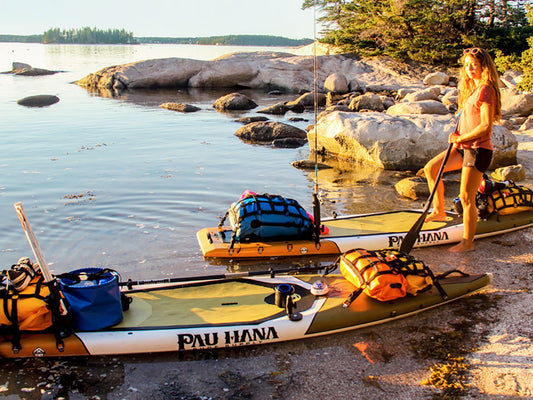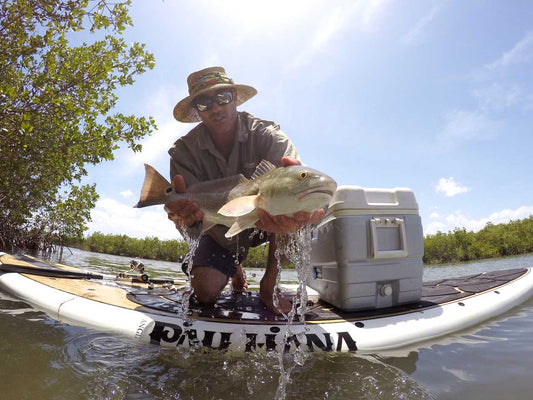Paddleboarding might look like a laid-back cruise across calm water, but spend a few minutes on a board and you’ll quickly realise it’s doing wonders for your whole body. Strength, balance, core stability - it all switches on the moment you step out onto the board and onto the water. And here in NZ where blue lakes, sheltered estuaries, and rugged coastlines are never far away, paddling becomes more than just exercise… it becomes an adventure.
If you’re keen to turn your time on the board into a powerful strength and core workout, here’s how to make every paddle count.
Why Paddleboarding Is Such an Effective Strength Workout
SUP is gentle on your joints but surprisingly tough on your muscles. Here’s what’s working behind the scenes each time you pick up your SUP paddle:
Your Core Never Gets a Break
Keeping your balance on a moving surface is basically a full-time job for your core. Obliques, deep stabilisers, lower back - they all fire with every micro-adjustment and paddle stroke.
Upper Body Power in Every Stroke
Your shoulders, arms, chest, and back work together every time you plant your blade and pull. When done with good technique, the majority of your power actually comes from your core and torso rotation - but your upper body still gets plenty of love.
Your Legs Are Quietly Working Hard
Your quads, hamstrings, calves, and glutes are constantly correcting and supporting you as the water shifts. Even mellow paddles give you steady leg activation.
Balance & Stability Like Nothing on Land
No gym equipment can mimic the natural “wobble” of a board. Water challenges all your smaller stabilising muscles, building those smaller muscles with strength that carries over into hiking, running, lifting - and pretty much everything.
A Cardiovascular Boost on Demand
Cruise slow for aerobic conditioning, ramp up the pace for intervals, or battle a headwind for a spicy heart-rate spike. SUP can be tailored for as gentle or intense as you want your workout to be.
Technique Tips to Get the Most Out of Every Paddle
Paddling with good form doesn’t just help you paddle faster and more efficiently - it protects your body and makes your workout far more effective.
Find Your Stance
Your feet should be shoulder-width apart, your weight should be even, knees soft and eyes forward. Think “strong but relaxed.”
Use Your Core, Not Just Your Arms
Twist from your torso and drive power from your core and lats. Your paddle blade should fully enter the water before you pull it back.
Maintain Tall, Confident Posture
Keeping your spine straight with relaxed shoulders and keeping your gaze on the horizon. This reduces strain and keeps your breathing free and easy.
Strength & Core Exercises You Can Do Right on Your SUP
These on-water exercises turn any session into a full training circuit - no gym needed.
1. Paddle Intervals
How: Paddle at an easy pace for 3-5 minutes, then sprint hard for 30-60 seconds. Repeat for 20-40 minutes.
Why: Intervals train your heart, lungs, core, and shoulders all at once.
2. Standing Core Twists
How: Hold your paddle horizontally and rotate your torso side to side while keeping your hips steady. You can add weight (like a water bottle or packed dry bag) for extra challenge.
Why: It builds rotational strength and targets your obliques.
3. Plank Holds on the Board
How: From kneeling, place your hands on the deck and step back into a plank. Hold for 20 - 30 seconds. Repeat for 5 rounds.
Why: A core burner that also improves stability thanks to the moving surface.
4. SUP Squats
How: Perform slow, controlled squats for 12-15 reps, making sure your legs reach a 90º angle. Rest, then repeat for 4 rounds.
Why: Squats strengthen quads and glutes while improving balance and control.
5. Paddle Lunges
How: Step into a lunge, pause, take a few strokes, and switch sides. Repeat for 10 minuets.
Why: Trains leg strength, coordination, and core alignment simultaneously.
Make the Most of New Zealand’s Unique Waterways
One of the best parts of SUP training here in NZ is the sheer variety:
Flat Lakes
Perfect for beginners and controlled core-focused workouts and yoga sessions.
Coastal Paddling
Swells, wind, and chop add natural resistance and extra balance is required- think of it as your balance training on “hard mode.”
Rivers & Estuaries
Places like the Whanganui offer lush scenery and a steady endurance challenge.
Pro tip: Always check conditions before heading out. Wind and tides can change the entire feel of your workout, and its good to know what you are getting yourself into.
How to Build a Consistent SUP Workout Habit
Start Small
Short paddles focused on technique build confidence without overwhelming your body. Start with smaller shower sessions consistently and build up the intensity over time.
Mix Up Your Sessions
Mix up Intervals, yoga flows, slow endurance paddles - variety keeps your training fun, mind focused and your muscles guessing.
Track Your Wins
Log your distance, calories, speed, or heart rate. Seeing progress over time is incredibly motivating.
Safety First - Always
- Wear a lifejacket or buoyancy aid
- Use a leash every time
- Bring water (hydration sneaks away fast on sunny days)
- Protect yourself from the sun
- Know when to call it - especially in strong currents or unfamiliar spots
Final Thoughts
Paddleboarding isn’t just a scenic way to spend a day - it’s a powerful, low-impact strength workout that fires up your core, tones your whole body, and keeps your heart healthy, all while giving you front-row seats to some of New Zealand’s most beautiful places.
Add a few structured exercises, focus on your technique, and suddenly you’ve got a training routine that feels way more like play than work.





